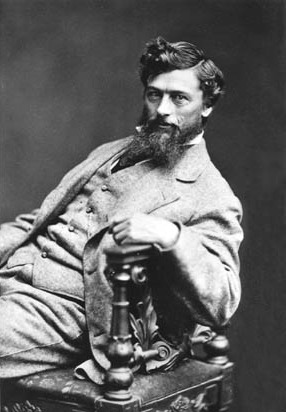George Inness (George Inness)

Artist. Born near Newburgh, New York, was the fifth of thirteen children, his father, a prosperous grocer, tried to make a grocer out of him, but the youth decided instead to become an artist. Around 1841, he received a month’s instruction from John Jesse Barker, a painter living in Newark, New Jersey, where the Inness family had moved in 1829. From the age of sixteen, Inness served a two-year apprenticeship as an engraver with the New York mapmaking firm of Sherman and Smith. He took some instruction in painting from Régis Gignoux about 1843, around the time he was studying and being influenced by prints of the paintings of Claude Lorrain and the seventeenth-century Dutch landscape masters. He was also seeing the work of the leading Hudson River School painters, particularly that of Thomas Cole and Asher B. Durand, whose style is recalled in some of his early canvases. By the late 1840s, Inness was exhibiting regularly in New York. Inness and his ! family left New York in 1860, moving first to Medfield, Massachusetts, and later to an estate near Perth Amboy, New Jersey. In the early 1860s, fellow artist William Page introduced Inness to the theories of Emanuel Swedenborg, which made a deep and lasting impression on him; indeed, became a major force in his intellectual life. Throughout that decade, spent in rural surroundings, he sought to make his paintings convey the profound spiritual meaning he felt the landscape around him possessed. In 1870, the Innesses moved to Italy for four years, during which time the artist sent back paintings to be sold by the Boston dealers Williams and Everett, receiving in exchange regular monthly payments. Stopping again in Paris on the way back to the United States, in 1874, Inness first saw works by the Impressionists in an exhibition he visited, but he thought little of that new style of painting. In 1878, Inness’s fortunes improved when Thomas B. Clarke, a prominent New York art dealer, became his agent. He took a studio in the New York University Building and bought a house and studio in Montclair, New Jersey. His theories on painting were published in Harper’s New Monthly Magazine in 1878 and 1882; in 1882, Charles De Kay, under the pseudonym Henry Eckford, wrote an important critical article about his work. Two years later, a major exhibition of Inness’s work was sponsored by John E Sutton, proprietor of the American Art Association, from which the artist emerged as the leading light in American landscape painting, an eminent position he enjoyed for the rest of his career. During the last years of his life, he spent summers traveling and painting in Connecticut, New York, Massachusetts, Virginia, California, and Florida. He and his wife returned to Europe in 1894, when Inness once again visited Paris, as well as Baden-Baden and Munich. On his way home, he died of a stroke in the Bridge of Allan, a small Scottish resort village. On 23 August 1894, the National Academy of Design held an impressive funeral service for Inness, who was by then one of its most illustrious members. (bio by: MC) Family links: Children: George Inness (1854 – 1926)* *Calculated relationship
Born
- May, 01, 1825
- USA
Died
- August, 08, 1894
- Scotland
Cemetery
- Rosedale Cemetery
- USA

